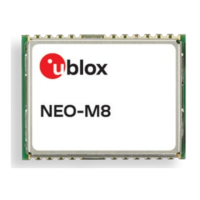NEO-8Q / NEO-M8 - Hardware integration manual
UBX-15029985 - Production information Product handling Page 26 of 27
C1-Public
Measures against in-band interference include:
• Maintaining a good grounding concept in the design
• Shielding
• Layout optimization
• Filtering
• Placement of the GNSS antenna
• Adding a CDMA, cellular, WCDMA band pass filter before handset antenna
Out-band interference
Out-band interference is caused by signal frequencies that are different from the GNSS carrier (see
Figure 16). The main sources are wireless communication systems such as cellular, CDMA, WCDMA,
Wi-Fi, BT, etc.
Figure 16: Out-band interference signals
Measures against out-band interference include maintaining a good grounding concept in the design
and adding a SAW or band pass ceramic filter (as recommend in section 4) into the antenna input line
to the GNSS receiver (see Figure 17).
Figure 17: Measures against out-band interference
☞ For design-in recommendations in combination to cellular operation see the Appendix.
☞ See the GPS Implementation and Aiding Features in u-blox wireless modules [8].

